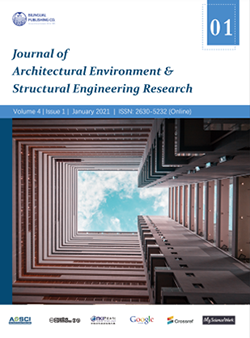-
370
-
218
-
182
-
180
-
173
Impact of Procurement Methods and Procurement Requirements on Cost Over-run of Public Building Projects in Uganda
DOI:
https://doi.org/10.30564/jaeser.v4i1.2787Abstract
Cost over-run in building projects is endemic and routinely increases construction cost to as high as 52% of contract sums in Uganda. The consequence of this is underachievement of investment objectives due to additional costs to complete projects. This research investigated how procurement requirements and procurement methods combine to determine cost over-run of building projects. Procurement requirements of bid time, performance bond, insurance, workload and experience of contractors were investigated within contexts of procurement methods of open domestic bidding, restricted domestic bidding, open international bidding, restricted international bidding and requests for quotations. Purposive and snow-ball sampling were used in identifying construction professionals, consultants and contractors of building projects with cost over-runs. Correlation and independence of procurement requirements on 37 cost over-run datasets were analysed by Spearman's bivariate correlation co-efficient at 5% level of significance and variable inflationary factor of less than 5 respectively. Bid time and performance bond were found to reduce cost over-run of building projects most followed by workload and experience. Insurance increased cost over-run marginally. The novel contribution of this research is a model that explains 63% of cost over-run with 9% margin of error. The variants of the model for each procurement method are presentedKeywords:
Bidding time; Performance Bond; Insurance; Workload; Contractor’ ExperienceReferences
[1] Office of the Prime Minister of Uganda, Local Government Management of Service Delivery Assessment Manual, Uganda Government, Kampala-Uganda, 2020.
[2] O. Sindhu, S. Karithiyayin, P. Ezhilmathi, Study on cost over-runs in construction projects: a review, International Journal of Applied Engineering Research 11(3) (2016) 356-363.
[3] K. Chitkara, Construction project management: planning, scheduling and controlling, 2ed. ed., Tata McGraw Hill Publishing Company, New Delhi, India, 2015.
[4] Uganda Bureau of Statistics, The national population and housing census-2014 - main report, Uganda Government Printery, Kampala, Uganda, 2016.
[5] M. Farmer, Farmer review of the UK construction labour model, Construction Leadership Council (CLC), London-United Kingdom, 2016.
[6] J. Egan, Rethinking construction, Her Majesty’s Service Office, London, United Kingdom, 1998.
[7] A. Trombka, C. Scruggs, Change orders in county government construction projects, Office of Legislative Oversight (OLO), USA, 2014.
[8] H. Alinaitwe, R. Apolot, D. Tindiwensi, Investigation into the causes of delays and cost over-runs in Uganda’s public sector construction, Journal of Construction in Developing Countries 18 (2014) 33-47.
[9] Q. Hao, W. Shen, K. Neelamkavil, A study of change order in construction projects, Institute for Research and Construction, 2008.
[10] A. Wolstenholme, A review of progress since rethinking construction and thoughts for the future: a review, Construction Excellence in the Built Environment, Warwick, United Kingdom, 2009.
[11] I. Mohamad, A. Mohammad, B. Amur, Design changes in reinforced concrete buildings, Journal of Construction in Developing Countries 17(2) (2012) 23-44.
[12] C. Nahod, Scope changes through managing changes in construction projects, University of Zagreb, Zagreb, 2012.
[13] A. Ade, H. Aftab, I. Rahman, A. Karim, Controlling cost over-run factors in construction projects in Malaysia, Research Journal of Applied Sciences, Engineering and Technology 5(8) (2013) 2621-2629.
[14] A. Alaryan, A. Elshahat, M. Dawood, Causes and effects of change orders on construction projects in Kuwait, Journal of Engineering Research and Applications 4(7) (2014) 1-8.
[15] J. Assbeihat, G. Sweiss, Factors affecting change orders in public construction projects, International Journal of Applied Science and Technology (2015).
[16] S. Ghaleb, J. Rateb, A. Mallek, E. Samer, Cost overruns in public construction projects: the case of Jordan, Journal of American Science 3(4) (2013) 1-6.
[17] M. Gokulkarthi, K. Gowrishankar, Managing changes in construction, International Journal of Science and Engineering 3(4) (2015) 1-6.
[18] K. Jayasudha, B. Vidivelli, Analysis of major risks in construction projects, Journal of Engineering and Applied Sciences 3(4) (2016) 6943-6950.
[19] P. Rezakhani, Classifying key risk factors in construction projects, Kyungpook National University, Kyungpook, South Korea, 2012.
[20] A. El-Kholy, Predicting cost over-run in construction projects, International Journal of Construction Engineering and Management 4(4) (2015) 95-105.
[21] H. Kalechosfsky, A simple framework of building predictive models, 2016.
[22] M. Markela, P. Llukan, Some indicators for testing the accuracy of a prediction model and codes in Matlab, 1st International Symposium on Computing in Informatics and Mathematics, 2011, pp. 575-582.
[23] C. Janssens, F. Martens, Prediction research: an introduction, 2014.
[24] Project Management Institute, A guide to project management body of knowledge, Project Management Inc., Pennsylvania, USA, 2013.
[25] H. Qi, S. Weiming, J. Neelamkavil, J. Russ, Change management in construction projects, International Conference in Information Technology in Construction Santiago, Chile, 2008, pp. 1-9.
[26] B. Erdogan, C. Anumba, D. Bouchlagem, Y. Nielsen, Change management in construction: the current context, Proceedings of 21st Annual ARCOM Conference, Association of Researchers in Construction Management, Leeds-United KIngdom, 2005.
[27] R. Okada, A. Simons, A. Sattineni, Owner requested changes in the design and construction of government healthcare facilities, 2017.
[28] M. Staiti, M. Othman, A. Jaason, Impact of change orders in the construction sector in the West Bank, Proceedings of 2016 International Conference on Industrial Engineering and Operations management IEOM Society International, Kuala Lumpar, Malaysia, 2016, pp. 1690-1698.
[29] F. Brunes, H. Lind, Explaining cost over-runs in infrastructural projects: a framework with applications to Sweden, Journal of Construction in Developing Countries (2014).
[30] A. Rauzana, Cost over-runs and failures in construction projects, Journal of Business and Management (2016).
[31] J.C. Kwio-Tamale, N. Kibwami, G. Mwesige, Predicting Cost Over-run of Building Projects Using Public Procurement Requirements- A Case of Uganda, International Journal of Construction Engineering and Management 9(5) (2020) 171-181.
[32] Public Procurement and Disposal Authority, Revised procurement guidelines (2014), Uganda Government Printer, Kampala, Uganda, 2017.




 Julius Caesar Kwio-Tamale
Julius Caesar Kwio-Tamale





